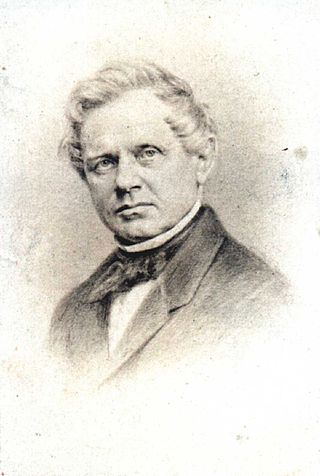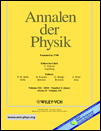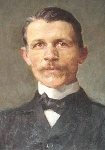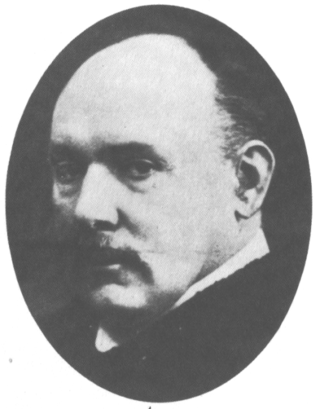
Heinrich Rudolf Hertz was a German physicist who first conclusively proved the existence of the electromagnetic waves predicted by James Clerk Maxwell's equations of electromagnetism. The unit of frequency, cycle per second, was named the "hertz" in his honor.

Heinrich Gustav Magnus was a notable German experimental scientist. His training was mostly in chemistry but his later research was mostly in physics. He spent the great bulk of his career at the University of Berlin, where he is remembered for his laboratory teaching as much as for his original research. He did not use his first given name, and was known throughout his life as Gustav Magnus.

Paschen's law is an equation that gives the breakdown voltage, that is, the voltage necessary to start a discharge or electric arc, between two electrodes in a gas as a function of pressure and gap length. It is named after Friedrich Paschen who discovered it empirically in 1889.

Annalen der Physik is one of the oldest scientific journals on physics; it has been published since 1799. The journal publishes original, peer-reviewed papers on experimental, theoretical, applied, and mathematical physics and related areas. The editor-in-chief is Stefan Hildebrandt. Prior to 2008, its ISO 4 abbreviation was Ann. Phys. (Leipzig), after 2008 it became Ann. Phys. (Berl.).

Knut Johan Ångström was a Swedish physicist. He was the son of physicist Anders Jonas Ångström and studied in Uppsala from 1877 to 1884, when he received his licentiat-degree, before going for a short time to the University of Strassburg (Strasbourg) to study with August Kundt. Coming back to Uppsala, he completed his doctoral degree and was appointed lecturer in physics at the new university college in Stockholm in 1885. After a few years working there, he returned to Uppsala in 1891 and received the professorship of Physics in 1896.

High voltage electricity refers to electrical potential large enough to cause injury or damage. In certain industries, high voltage refers to voltage above a certain threshold. Equipment and conductors that carry high voltage warrant special safety requirements and procedures.

Heinrich Gustav Johannes Kayser ForMemRS was a German physicist and spectroscopist.

Erich Rudolf Alexander Regener was a German physicist known primarily for the design and construction of instruments to measure cosmic ray intensity at various altitudes. He is also known for predicting a 2.8 K cosmic background radiation, for the invention of the scintillation counter which contributed to the discovery of the structure of the atom, for his calculation of the charge of an electron and for his early work on atmospheric ozone. He is also credited with the first use of rockets for scientific research.
Kurd Friedrich Rudolf von Mosengeil, also Curd Friedrich Rudolf von Mosengeil, was a German physicist.
Jakob Johann Laub was a physicist from Austria-Hungary, who is best known for his work with Albert Einstein in the early period of special relativity.

Alfred Heinrich Bucherer was a German physicist, who is known for his experiments on relativistic mass. He also was the first who used the phrase "theory of relativity" for Einstein's theory of special relativity.

Vladimir Sergeyevitch Ignatowski, or Waldemar Sergius von Ignatowsky and similar names in other publications, was a Russian physicist.

Eduard August Grüneisen was a German physicist. The dimensionless thermodynamic measure known as Grüneisen parameter is named after him.
Herbert Arthur Stuart was a German experimental physicist who made contributions in molecular physics research. During World War II, he was director of the experimental physics department at the Technische Hochschule Dresden. From 1955, he was the head of the high polymer physics laboratory at the University of Mainz.

Otto Heinrich Wiener was a German physicist.
Eduard Rüchardt was a German physicist. In modern times Rüchardt is mainly noted for the experiment named after him. However, Rüchardt's chief topic was the study of canal rays. This work started under the supervision of Wilhelm Wien and continued later in collaborations with Walther Gerlach.
Hilda Hänchen was a German physicist.
Hermann Fritz Gustav Goos was a German physicist and astronomer.
The hollow cathode effect allows electrical conduction at a lower voltage or with more current in a cold-cathode gas-discharge lamp when the cathode is a conductive tube open at one end than a similar lamp with a flat cathode. The hollow cathode effect was recognized by Friedrich Paschen in 1916.

Ernst Heinrich Paul Albert Wigand, known as Albert Wigand, was a German professor who lectured in the fields of physics, geodesy, meteorology and climatology. His is most well-known as one of the earliest physicists to successfully devise a method of studying fog and cloud matter in mid-air. In his later years, he became a fierce supporter of the xenophobic and nationalist thinking that would underpin Nazi ideology, and that association has clouded his legacy.













